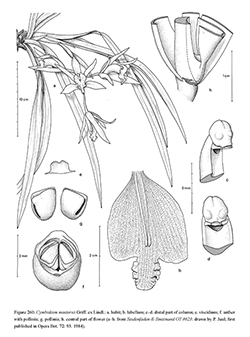e-Flora of Thailand
Volume 12 > Part 2 > Year 2014 > Page 464 > Orchidaceae > Cymbidium
14. Cymbidium mastersii Griff. ex Lindl.wfo-0000934524
Edwards’s Bot. Reg. 31: t. 50. 1845; Seidenf., Opera Bot. 72: 91, fig. 52, t. VId. 1984; Du Puy & P.J.Cribb, Gen. Cymbidium: 212, fig. 120–123, 125(2), t. 25, map 30. 2007.— Cyperorchis mastersii (Griff. ex Lindl.) Benth., J. Linn. Soc., Bot. 18: 318. 1881. Fig. 260.
Accepted Name : This is currently accepted.
Synonyms & Citations :
Description : Epiphytic or lithophytic herb. Pseudobulbs stem-like and inconspicuous within the numerous persistent leaf bases, growing indeterminately, with cauline roots, the older growth appearing flattened and elongated. Leaves 16–17, distichous, up to 64 by 1.8 cm, arching, narrowly ligulate, tapering to an acute, usually unequally bilobed apex with a mucro in the sinus. Inflorescence ca 25–30 cm long; rachis 5–10 cm long, arcuate or pendulous, not strongly exerted from the sheaths, with 5–15 closely spaced flowers; bracts 2–7 mm long. Flowers ca 6 cm across, not opening widely; almond-scented; petals and sepals white or faintly pink; labellum white, usually with a yellow central patch at the base of the mid-lobe, and bright yellow ridges. Dorsal sepal 43–52 by 8–11 mm, narrowly oblong-elliptic to narrowly obovate, acute, concave, not spreading except towards the tips; lateral sepals similar, curved. Petals 39–49 by 5–7 mm, narrowly ligulate or narrowly obovate, slightly curved, porrect. Labellum 40–44 by 20–24 mm, fused to the base of the column for 3–5 mm; side lobes 10–12 mm broad, lightly clasping the column, minutely hairy, apex broadly rounded to subacute and porrect, margin minutely fringed at the front; mid-lobe 10–13 by 10–13 mm, ovate, rounded or mucronate, porrect, minutely hairy with a dense central and basal patch of short hairs, margin undulating; ornaments of 2 slightly raised, well-separated ridges behind, sometimes minutely auriculate and forming a small trough shaped depression at the base, inflated and converging towards the hairy apex at the base of the mid-lobe. Column 33–36(–40) mm long; pollinia 2. Capsule broadly ellipsoid, ca 3 by 2.5 cm.
Thailand : NORTHERN: Mae Hong Son, Chiang Mai; NORTH-EASTERN: Loei.
Distribution : N India (Sikkim, Meghalaya, Manipur), Myanmar, S China (NW to SE Yunnan); 1,350–1,600 m alt. Type prepared from a cultivated plant of unknown provenance.
Ecology : On rocks and trees in evergreen forests, often in deep shade, in humus, moss or on rotting wood. Flowering: September–December.
Vernacular : Samphao inthanon (สำเภาอินทนนท์)(Chiang Mai).

